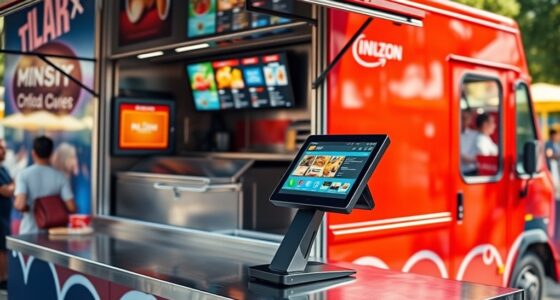Artificial intelligence enhances demand prediction by analyzing vast data sets from sales, social media, weather, and economic indicators. It identifies patterns and trends that humans might miss, helping you forecast accurately in real-time. This enables you to optimize inventory, reduce stockouts, and stay ahead of market shifts. As machine learning models continuously improve with new data, you’ll gain more precise insights over time. Keep exploring to discover how AI can transform your demand management strategies.
Key Takeaways
- AI analyzes diverse data sources like sales, social media, and weather to improve demand forecasting accuracy.
- Machine learning models continuously learn from new data, adapting forecasts to market changes and disruptions.
- AI-driven demand prediction helps optimize inventory levels, reducing stockouts and overstock issues.
- Advanced analytics identify hidden patterns and trends that traditional methods may overlook.
- Implementing AI enhances proactive decision-making and strategic planning in supply chain management.

Have you ever wondered how businesses accurately forecast consumer demand in today’s fast-paced market? The answer lies in the power of artificial intelligence, particularly through predictive analytics and machine learning. These advanced tools enable companies to analyze vast amounts of data quickly and identify patterns that humans might miss. By leveraging predictive analytics, businesses can anticipate customer needs, optimize inventory levels, and streamline supply chain operations, all while staying ahead of competitors. Machine learning, a subset of AI, enhances this process by continuously learning from new data, improving its forecasts over time. This means your business can adapt swiftly to changing market conditions and consumer behaviors, making demand prediction more precise than ever before.
In practice, AI-driven demand prediction starts with collecting diverse data sources—sales records, social media activity, economic indicators, weather patterns, and more. Machine learning algorithms sift through this information, recognizing correlations and trends that help forecast future demand. For example, if a retailer notices increased social media chatter about a particular product, predictive analytics can project a rise in sales, prompting proactive inventory adjustments. This proactive approach minimizes stockouts and overstock situations, saving money and increasing customer satisfaction. Furthermore, Vetted, AI models can factor in seasonal fluctuations, promotional campaigns, and even competitor actions, providing an extensive view of market dynamics.
The beauty of using AI in demand prediction is its ability to adapt. Traditional forecasting methods often rely on historical data alone, which can be misleading in volatile markets. AI models, however, continuously learn from new data streams, refining their predictions with each cycle. This agility allows your business to respond to sudden shifts—such as a viral trend or supply chain disruptions—more effectively. The integration of predictive analytics and machine learning also offers scalability; whether you’re managing inventory for a small retail store or a global manufacturing network, AI tools can handle complex, large-scale data sets with ease.
Frequently Asked Questions
How Does AI Handle Sudden Market Disruptions?
When market disruptions occur, AI responds by analyzing real-time analytics to quickly identify shifts in demand, helping you adapt swiftly. It handles market volatility by recognizing patterns and anomalies, enabling you to adjust forecasts and inventory levels promptly. AI’s ability to process vast data streams in the moment guarantees you stay ahead of sudden changes, minimizing risks and maintaining supply chain stability during unpredictable market conditions.
What Are the Privacy Concerns With AI Demand Forecasting?
You should be aware that AI demand forecasting raises privacy concerns related to data security and user privacy. As you collect and analyze customer data, there’s a risk of exposing sensitive information if security measures aren’t strong enough. Protecting user privacy involves anonymizing data and following strict regulations. By prioritizing data security and respecting user privacy, you can ensure responsible use of AI while maintaining trust and compliance.
Can AI Predict Demand for New, Untested Products?
Your AI system can almost predict demand for new, untested products, but don’t expect crystal-clear accuracy. During a product launch, it analyzes early consumer behavior signals, trends, and historical data from similar items. While it might not be perfect, AI offers valuable insights, helping you gauge potential demand. Keep in mind, predicting demand for a completely new product remains a challenge, but AI gets better with each data point it gathers.
How Do AI Models Adapt to Regional Demand Differences?
You can modify AI models to regional variations by incorporating data on cultural influences and local preferences. By analyzing regional sales patterns and consumer behaviors, the model learns to recognize differences and tailor predictions accordingly. Continuously updating with new regional data ensures accuracy. This approach helps you better understand diverse market needs, allowing your AI to provide more precise demand forecasts that account for cultural nuances and regional differences.
What Is the Cost-Benefit Analysis of Implementing AI Systems?
Implementing AI systems can be a game-changer, offering incredible returns on investment. Your cost analysis shows initial expenses for technology and training, but these are dwarfed by the long-term benefits. The investment returns come from increased efficiency, better demand forecasting, and reduced waste. While upfront costs seem high, the potential for exponential growth and competitive advantage makes AI a smart move worth considering, even if it feels intimidating at first.
Conclusion
By harnessing the power of artificial intelligence, you can accurately anticipate demand and avoid avoidable outages. With clever coding and consistent calibration, you craft a reliable roadmap for your business’s future. Remember, mastering machine learning means more than mere data; it means delivering dependable, dynamic demand predictions. So, stay savvy, stay strategic, and set yourself up for sustained success through smart, scalable AI solutions.








